Sign in to create or edit a product review. 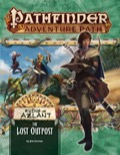
Pathfinder Adventure Path #121: The Lost Outpost (Ruins of Azlant 1 of 6) (PFRPG)Paizo Inc.Add Print Edition $24.99 Add PDF $19.99 Non-Mint Unavailable Sinister and SubtleI was a player in this, so just a brief review from that perspective. There were some drawbacks, certainly, but what's strong is really strong. That remains true for the entirety of this AP. There is a tough start to this one! A few bad rolls would've seen us wipe on the very first encounter, but of course that is subjective. I really liked the sinister and mysterious atmosphere here. We truly had no idea what had gone on, and though some of the encounters were a bit basic, it still did a good job of feeling disconcerting and dangerous. After the initial discovery of the lost colony, I think the latter second half was the strongest part. I enjoy when Adventure Paths let you get a strong sense of the theme early on, even if they don't let on exactly what's going on. The last area and boss really felt like a completely unique experience to this AP. One criticism that remains consistent throughout this game is that the social stuff is a little weak, and largely falls back to 'people are dissatisfied and you need to appease them'. I understand, obviously in this kind of situation such things are inevitable, but it doesn't mean it's fun to revisit time and again when you have much more important, life threatening things to attend to. Still, this remains one of my favorite games that Paizo has ever published. A completely unique experience which rewards an interest in Azlant and Azlanti technology, and truly does justice to the real villain (which I won't spoil here) 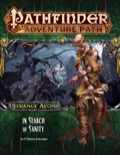
Pathfinder Adventure Path #109: In Search of Sanity (Strange Aeons 1 of 6) (PFRPG)Paizo Inc.Print Edition Unavailable Add PDF $19.99 Non-Mint Unavailable One of the best openers to an AP I've ever been inTo put it simply, I absolutely adored this book. I will never, ever forget the bizarre surreal experience of exploring the asylum and having no idea what was going on, the desperate struggle for survival, the dreamy, jaundiced quality to everything... just absolutely 10/10 on atmosphere. I was a player, so can't comment on anything behind the scenes. I want to give huge kudos to Paizo for setting a book in an asylum and not making mental illness the real terror, or making the place terrifying because of its mentally ill inmates. The place was beset by real monsters, which made the challenges faced by the staff who were trying to protect the patients all the more upsetting. The patients were handled sensitively and some were truly tragic, and none were monsters simply because of their afflictions. In a setting often beset by lazy, ignorant writing this was a real triumph. It's not easy to tackle cosmic horror in a game where the players are accustomed to being empowered and are assumed to be able to kill everything they face. I think this book handled it admirably. The encounters seemed a little harder than I'm used to in a first book (perhaps subjective) and the things themselves were horrifying enough that even defeating them wouldn't exclude us from the psychological trauma of facing them down. It rewards thoughtful roleplay with a thought to real psychological consequences. After reading other reviews of this entire AP, I realize that it holds much greater delights for those who are extremely familiar with the source material and perhaps comes across as bizarre or underwhelming for those who don't know it, or who have a very limited or stereotyped idea of what weird fiction and cosmic horror should be. That's a shame, but I want to add my voice to say that I think this AP was (largely) a unique and wonderful experience, and an excellent way to bring cosmic horror themes to a combat-oriented role playing game. One minor point of note - I don't think we'd have made it through this AP if we'd used the sanity system out of the box. Too many things would be utterly ruinous to the point where we'd have been gibbering idiots before even the halfway point. We just ran a houseruled version which worked neatly enough, though I'd be interested to hear how it went for anyone who just went for it as is! 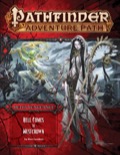
Pathfinder Adventure Path #108: Hell Comes to Westcrown (Hell's Vengeance 6 of 6) (PFRPG)Paizo Inc.
Add
Print Edition
Add PDF $19.99 Non-Mint Unavailable Unimaginative, by the numbers, designed to subvert playersWas in this as a player, so can't comment on anything behind the screen. This was certainly a High Level Game where you Fight Good Creatures. That's really the best that can be said for it. Sure, there were some interesting setpieces and enemies. But, why is everything in the city possessed of an artificially high stat block? I could swallow it if it were specifically Glorious Reclamation folk who were sent here to hold an important city, but it's not. Every random dude here is coincidentally at the right level for a book 6... for some reason. Others have said this but, holy heck where did you get all these paladins? It was a tad absurd even in Wrath, but isn't paladin supposed to be a somewhat unusual class which takes a remarkable level of personal dedication and really means something for the individual? They're a dime a dozen here, no big deal I guess. Which brings me on to my next point. Paladins have some nice immunities, as we all know. Some would say they have some extremely strong immunities. I say let them have their fun... usually at least. But when nigh on the only enemy you're facing is paladins, these things become very apparent. Let's be honest, a huge pull for this AP was the chance to play evil characters with evil abilities, access to domains you wouldn't usually get, antipaladin stuff etc. And as we learned in our group, a LOT of evil class features involve fear, charm, and compulsion. Yes, they're nasty things to do, but this is an -evil- game. The presence of so many paladins is a huge middle finger to a lot of the tactics and class features which are going to be favored by evil characters. I'm not sure what the impetus was for this decision, apart from to make sure the PCs don't have too much fun being evil, and are subverted as much as possible. It might be subjective to our group, but the final villain seemed to be completely out of nowhere, no fanfare, and no reputation build up at all prior to fighting her. Compare this to Hell's Rebels, it's extremely anticlimactic and underwhelming. Adding my voice to those fed up with the evil iconics. I'm sorry but the art is some of the worst I've ever seen, and they're horribly made characters. A couple of them are interesting enough in terms of story, but I'd love to know what drugs the person is on who decided that a duergar paladin is a sensible choice. 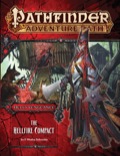
Pathfinder Adventure Path #103: The Hellfire Compact (Hell's Vengeance 1 of 6) (PFRPG)Paizo Inc.
Add
Print Edition
Add PDF $19.99 Non-Mint Unavailable The Worst Start to an AP I've Ever SeenI was a player in this, so I can't comment about things behind the screen. In our group, we like to make meaningful characters with genuine motives for what they do. As a long-time GM, I'm pretty used to playing villains who are also real people. Most people do not need help with this concept. Putting an NPC in to basically 'show the PCs the ropes' of being villainous was so patronizing I don't even have words for it. Also, starting the PCs mid-crime and just telling them to roll with it? Awful, abysmal idea. Who on earth thought this would be good? Just because you're playing evil characters it doesn't mean you suddenly don't need a reason for being an a~%!#@*. As someone who attempted to make a character with a halfway nuanced backstory (and a lawful one, mind) I was honestly blown away that this setpiece was the price of entry into this AP. Just go along with it or don't bother! Delightful. No other major problems with the town, setting, motives, villains. But Paizo's lack of experience in evil campaigns really shone here (and would continue to do so for the rest of the AP) 
Pathfinder Adventure Path #131: The Reaper's Right Hand (War for the Crown 5 of 6)Paizo Inc.Add Print Edition $24.99 Add PDF $19.99 Non-Mint Unavailable As with my previous reviews of books in this AP, once again I'm torn between wanting to like what's on offer, but being very dispirited by a conspicuous lack of attention to detail. The Good This book is overflowing with creative setpieces, monsters, NPCs, and unique scenarios that really couldn't be experienced anywhere else. After 4 books of Taldan intrigue, it feels like a nice change of pace which puts the PCs in a truly unexpected situation, without falling into the usual trap of distracting them from where they really want to be, and what they really want to be doing. The Bad For full disclosure, my group did not use the Persona subsystem in this AP. I was lukewarm on the idea, and after discussing it with my players, we decided it would not be fun for our particular group's way of playing. We're not overly keen on subsystems and abstractions, and favor detail and roleplay in all situations. In our case, we did not feel it would be a good fit. That's not a criticism of the system or its use in the AP, well, it wouldn't have been until this book. Until now, it was largely a background system which would bring good benefits for groups who cared to use, but the content available was sufficient that scenarios could easily be handled without using it. In this book, there are two entire setpieces (and one entire Part) which entirely rely on use of that subsystem. This isn't my complaint in and of itself, since it was my choice not to use it. My complaint is that both of these particular setpieces feel incredibly tacked on for the sake of the Persona system, and actually either bear no relevance to the wider AP, or could have been handled without it. The first is the section 'Of Landgraves and Landgrabs', where we briefly return to book 2 meta to once again step into a stagnant and neglected part of Taldor and start to try and convince the locals that our way is the best way, and win them over the benefit from local knowledge in order to locate something which could easily be handled in myriad other ways at this level. There's no inherent problem with it, but it's written exclusively for Persona rules with very little in the way of actual detail or any consideration for what happens if the PCs find another solution. Some potentially very meaningful NPC developed is entirely glossed over on route. The second is 'The Need to Lead', where despite having just arrived on Axis mere hours ago, the PCs can run for office! I don't mean to be disparaging of a setpiece which I'm sure could be a lot of fun for certain groups, but to me this just felt so tacked on for the sake providing a 'novel' experience, and once again fitting into the Persona subsystem. Other reviewers have mentioned this, but the very notion that agents can just casually be brought to Axis and the Persona system can continue unabated honestly beggars belief, and really stretches the intrigue and believability that should be so essential to an AP like this. In short, it feels inauthentic, and tacked on for the sake of novelty. How convenient that there's a governmental role that can only be filled by people who haven't lived here for very long! This belongs in a mod or a PFS scenario, and feels extremely out of place here. I wasn't a particular fan of the remarkable level of quirkiness on display in this book either. That is a matter of personal taste, but it felt like the writers were going out of their way to subvert what players might expect from traveling to the Plane of Law. I'm absolutely not saying it should have been some dehumanizing mechanical nightmare, but there were things which would have felt much more at home in the mod The Harrowing than a unique opportunity in an AP such as this. The bestiary was interesting, but the two new inevitables on offer felt very samey and visually unimaginative. I was also not at all enamored with the design of Taldaris. Hilariously, the generic art for the impariut inevitable had a stronger Taldaris energy than his own art. Finally, and most damning, the issue of The Stabbing Beast [vague Wrath of the Righteous spoilers below] Once upon a time, Paizo really cared about the developments that could reshape the world of Golarion. In Wrath of the Righteous, a deity's unique herald being messed with and killed was an incredibly big deal to that deity's faith. We were treated insight into the difficulties inherent in the lack of ability for deities to affect the Material Plane, and how a deity would respond when their herald was threatened. It's a big deal to the faith, to put it mildly. In this book, the PCs are directly confronted and fought by the herald of Norgorber himself. In the flesh. Given the stats of the thing, it shouldn't be unexpected or impossible to imagine that they could slay the creature, since there's no quality heralds have which makes them immortal on their home plane or anything. Given the sinister qualities of Norgorber, the fact that he is a deity on a par in power to Iomedae, that this is occurring in his actual divine realm, one would think that there should be some consequences to openly slaying his herald. At the very least, maybe a couple of words on how the faith is affected, how Norgorber responds in the moment. But no, not a one. Rather, the PCs stand around for some considerable amount of time trying to impress an NPC who is quite incapable of teleporting to safety. In fact, no one can get out fast due to the unique qualities of the realm. Apparently, despite this being in Duskfathom itself, Norgorber is completely okay with this, doesn't take any measures to disrupt their plans, lets them walk out unscathed, and everything just continues as if nothing ever happened. To me, this is emblematic of a bigger change in Paizo's recent Adventure Paths where there seems to be nonchalant lack of concern for the setting. Very little seems to matter anymore, and something like this just glossed over in favor of the PCs tackling a social encounter. Now, novelty and setpieces trump consequence and meaningful roleplay. Some fairly world changing events also occur in Tyrant's Grasp which are so glossed over at the end that the AP may as well never have existed. I really hope this trend does not continue and is just a consequence of writers being distracted by the pressures of 2E. 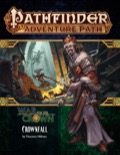
Pathfinder Adventure Path #127: Crownfall (War for the Crown 1 of 6)Paizo Inc.Add Print Edition $24.99 Add PDF $19.99 Non-Mint Unavailable Creative, But Lacking in FactsI feel very torn about this AP, because there's so much to like, but there's some really fundamental things which have consistently irritated me while running it. First of all, I want to echo another reviewer by talking a bit about terminology. I get a strong sense in this AP that the writer(s) was extremely excited by the notion of kicking back against the patriarchy, ABOLISHING PRIMOGENITURE and really making a strong change in Taldor. That's fine, lord knows the stuffy nation could use a kick up the backside. I'm British, so I know how that feels. But, honestly, it would have taken 2 minutes on Google to understand these core, fundamental terms that you're dealing with here. Rather than 'abolishing primogeniture', what you actually want to do is bring in Absolute Primogeniture. It's a lot less exciting isn't it? But still, it's correct. The thing we don't want here is called (as another reviewer noted) Agnatic Primogeniture, which means the first born male inherits. Absolute Primogeniture is when the first born inherits. Princess Eutropia is the first born, and so neatly altering the law to include all heirs is all that needed to happen. In fact, if you did indeed 'abolish' primogeniture, what you'd have on your hands is a complete and total sh*tshow. There wouldn't be an heir at all! The claim to the throne would come down to a billion other factors and poor Eutropia would probably be pushed out of the running altogether. It's really simple, but I can't tell whether it was overlooked because it didn't fit the 'punching up' narrative, or whether the writers heard the term, got excited, and did no further research at all. I wouldn't mind, but it's repeated so often throughout the AP, and it just feel like facts and terminology have twisted to fit some imagined narrative. I understand that Paizo are a US company and that this kind of stuff isn't common in their culture. I admit that even for a British person I'm a little more into this than the norm, but I would have thought that if you were going to write a whole AP about thrones and monarchy, you'd do your research. Unfortunately, it also shows that the setting of Taldor wasn't really built to withstand this level of noble intrigue. Quite simply, I don't think Paizo really understands how the aristocracy actually functions in the places of the world that have it. The way they handle titles and land ownership is spotty at best, and requires GMs to just run with what they're given in most cases because there's a severe dearth of facts and consistency when dealing with noble families and monarchy. This one has a lot in common with Ironfang Invasion in that it prioritizes style over substance too often, where lots of detail is given to NPCs and their personalities and motivations, and very little to the kind of concrete details GMs need in the heat of the moment. This brings me to my second issue with this AP as a whole - tone. In the mission statement for War for the Crown, it was sold very much as more nuanced experience than Hell's Rebels, where the PCs would work within the system to enact change, working with established hierarchies and affecting a steady, non-revolutionary change. Also, it would not be a glory seeking AP where the PCs are great heroes who overthrow the system. So far so good, I was very interested by that mission statement and had high hopes for a truly complex, intrigue experience. My group was very interested in the idea of playing primarily Lawful characters in this case. We'd had a great time being Chaotic revolutionaries in Hell's Rebels, but this sounded like something very different. It's not that the AP doesn't deliver on the intrigue side of things, but I couldn't shake the sense throughout that it would much -rather- have been about virtuous and chaotic revolutionaries who constantly seek glory by donning on masks and sticking it to the man. I mean, there's literally an entire subsystem about building cults of personality around the PCs, so I don't think it's fair to say this is about working behind the scenes simply because you're not using your own names. Within the very first setpiece, there's a strong expectation that the PCs are supposed to lie, cheat, steal, and defraud their way through problems. Of course, GMs are always free to make any changes they see fit, but I feel that there is a constant tension between what the AP said it wanted to be, and what it ended up being. The first installment was a fun mix of intrigue and challenging combat, and I have no problems at all with how it played out. There's just an irritating lack of care for the details in a story that really just wants to pit a compassionate woman against a stodgy, patriarchal man. There's nothing wrong with that narrative, but let's at least get the facts straight first. 
Pathfinder Adventure Path #120: Vault of the Onyx Citadel (Ironfang Invasion 6 of 6) (PFRPG)Paizo Inc.Add Print Edition $24.99 Add PDF $19.99 Non-Mint Unavailable Beware if you use Golarion as a setting[Spoilers for this book, and also Lost Omens] I want to say first off that there is nothing wrong at all with this book in isolation. It provides a rich and varied experience with fascinating locations, unusual enemies, and a real sense of gravitas over what is happening in the world. It well deserves the otherwise good reviews in an of itself. As someone in a group who plays in a setting where the ends of APs matter and go on to shape the geopolitics of the world, I feel obliged to speak up about this book now that the Lost Omens campaign setting has released. This AP did a great job of bringing out the horrors of war and the fate of simple, everyday folk in the face of a violent and oppressive invasion. As some other reviewers have observed, it had a very Lord of the Rings feel about it. It started by making the PCs feel utterly powerless, and then let them gradually gain power and prestige as they were able to stand up against a very real terror that threatened the life of their loved ones and their country. It should go without saying that villains need a good motivation for their deeds, and Azaersi was a compelling and complex villain from the very beginning. She had her own history and reasons for doing what she did, but I feel that her (potential) 11th hour turnaround was extremely poorly handled. Never once was she portrayed in the previous 5.5 books as anything other than a terrifying tyrant, and the PCs had not only suffered at the hands of her finest, hand-selected generals, but they'd seen the utter misery wrought on countless innocents at the hands of the Ironfang Legion. Thus, in every meaningful sense of the word, this was a classic heroic story with a genuine villain. The fact that the villain had good reasons for doing what she did should not stop her being a villain. Any good villain should have a motive, and complexity is always welcome. However, she pursued her goals through violence and subjugation, and fact that some of the creatures involved had been negatively stereotyped or mistreated in the past didn't erase that fact that she was waging a race war on a peaceful nation unable to defend itself. The fact that, at the very last minute, you are able to exploit a squabble with a friend to 'talk her down' from her schemes has already been acknowledged as utterly ridiculous and out of character with the rest of the AP. I don't buy it as the 'super tough general actually has a soft side'; Azaersi as a person at this point has not earned that level of sympathy or understanding for what she's done. The fact that she can be talked down with a series of skill checks that are not especially challenging at that level is not only underwhelming as an end to the campaign, it's downright insulting to the PCs and their allies who have suffered under the tyrannical torment of her army. Because it's not enough that she's talked down, no. She is also persuaded to peacefully treat with the PCs to 'give her people a home', which would be all well and good if it wasn't for the fact it's not just a random convenient empty nation that just happened to open up and would happily host a trained army of vicious warmongers. It's a pleasant demiplane in the Plane of Earth which already has native residents who probably don't particularly wish for their peaceful natural home to be flooded with a now-directionless Lawful Evil military. There are native creatures and cultures on that plane who don't get a single say in this, and frankly I thought Paizo was better than that. Portraying this as somehow a 'good' ending simply because Azaersi is a complex villain is disingenuous to an absurd degree. I think the fact that this option exists is ridiculous and thoughtless, but I just accepted that some people might enjoy that and left it well alone. Its existence doesn't affect me or my players. Until now. With the release of the Lost Omens campaign setting, we are told in no uncertain terms that this was, in fact, the CANONICAL end of Ironfang Invasion. Sorry to any players who rightfully defeated Azaersi and her army and did anything more meaningful with the Onyx Citadel, but that's how it went. I'm sorry to say that this felt like it was written by an imaginative yet inexperienced GM who was far too in love with her villain, and wanted all the power and prestige of being a violent tyrant, but not the consequence of actually losing the character. The fact that Azaersi's survival and the establishment of a hobgoblin nation is canon now makes many of the stories told by Irongfang Invasion meaningless. Any GM running this who uses Golarion as a setting and plans to move to 2E should know this before getting into it. Of course, you can always ignore or customize anything you wish to, but you're going to have to ignore some fairly substantial developments in Lost Omens, and certainly hope that there aren't any further adventures or intrigues which touch on this. |



